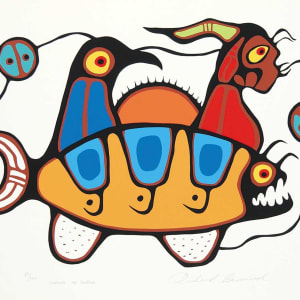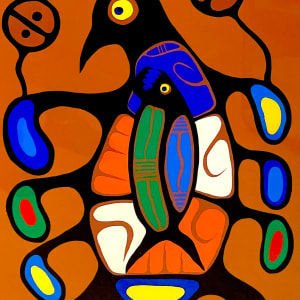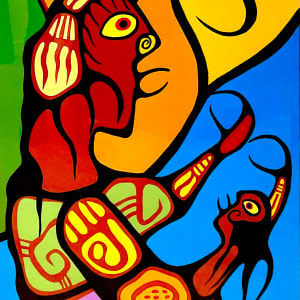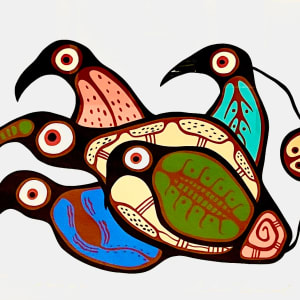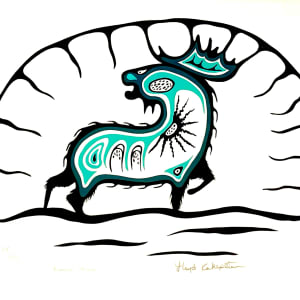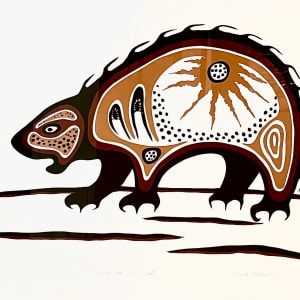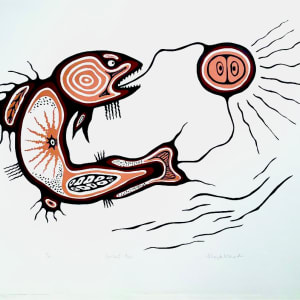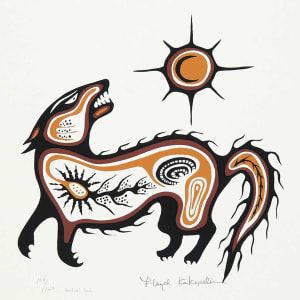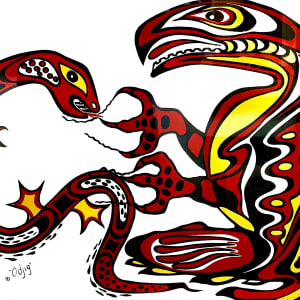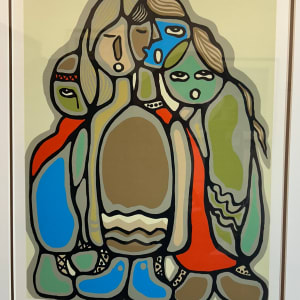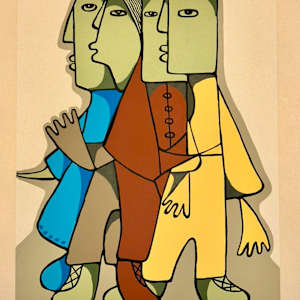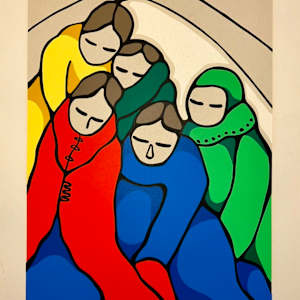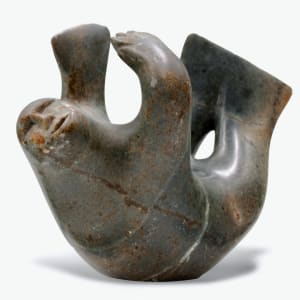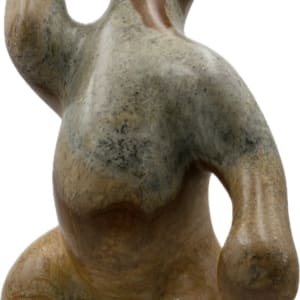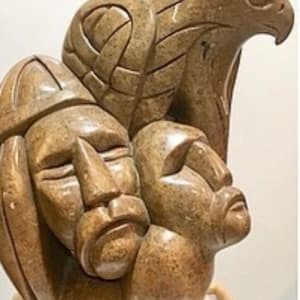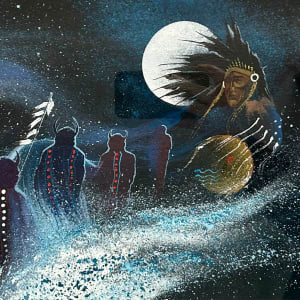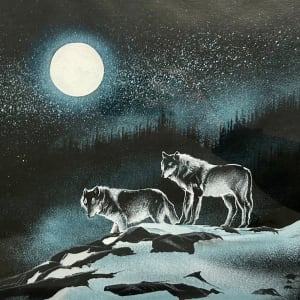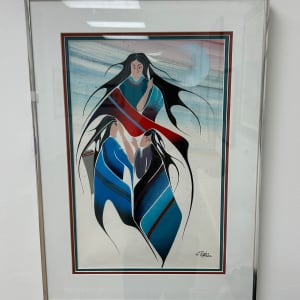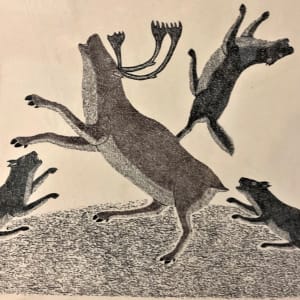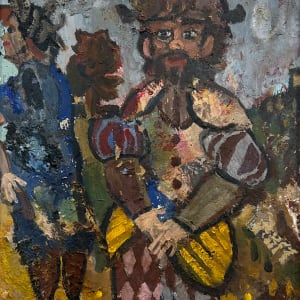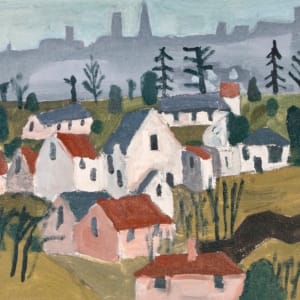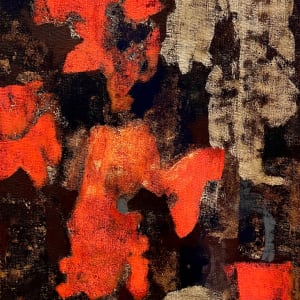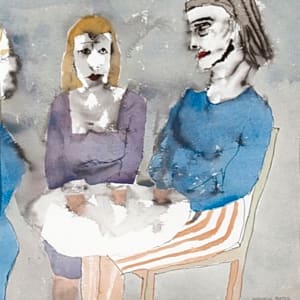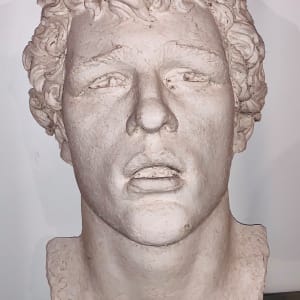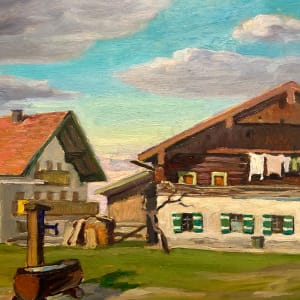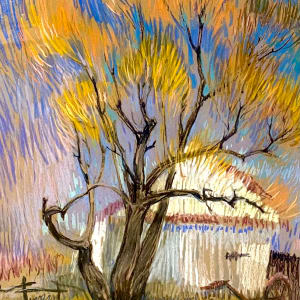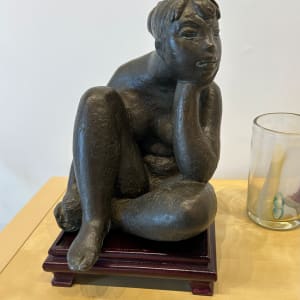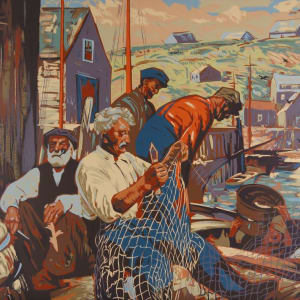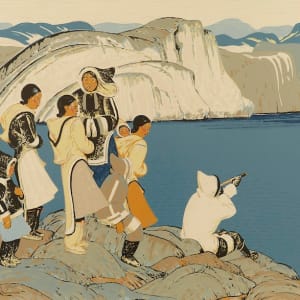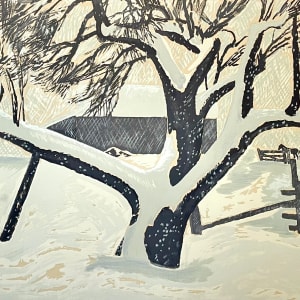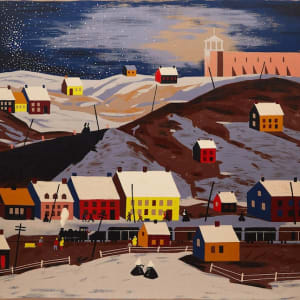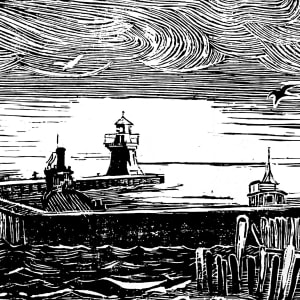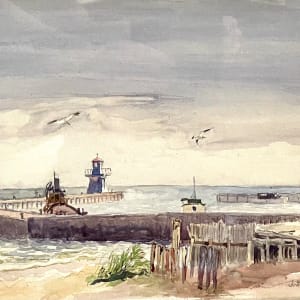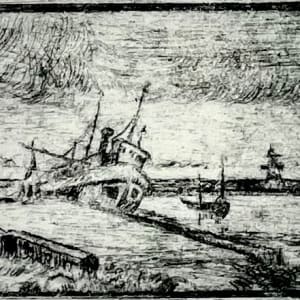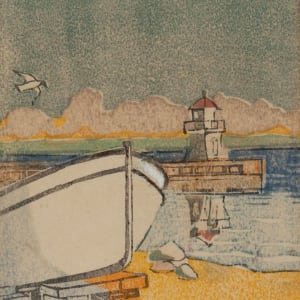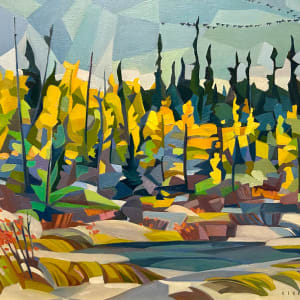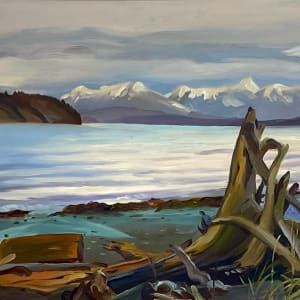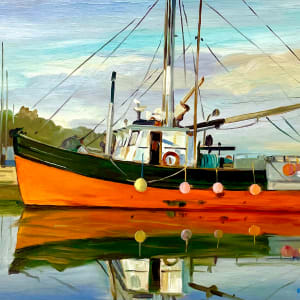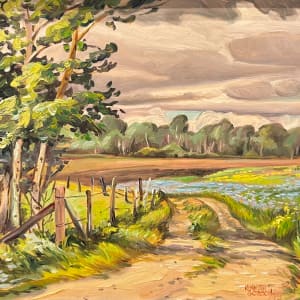Peter Aliknak Banksland (1928-1998)
Peter Aliknak Banksland (1928–1998) was an Inuit carver and printmaker from Utkraluk (Baillie Island), NT. He moved to Ulukhaktok (Holman Island) in 1934 and became a founding artist of the Holman Printmaking program. Primarily a printmaker, he explored techniques such as stonecut, lithography, and etching, depicting traditional Inuit life amid rapid cultural change. His stylized prints, characterized by expressive figures and minimal color, focused on storytelling rather than realism. Banksland’s work has been widely exhibited and is held in major collections, including the National Gallery of Canada and the National Museum of the American Indian.
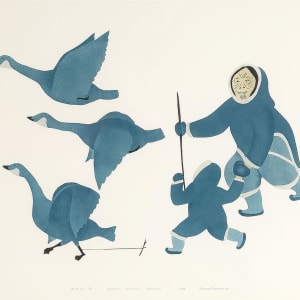
Richard Bedwash (1936-2007) - Anishinaabe (Ojibwe)
Richard Bedwash (1945–2007) was an Ojibway artist whose work reflects the pictographic style and spiritual themes of his mentor, Norval Morrisseau. A student of Morrisseau from 1966 to 1968, Bedwash adopted a bold use of organic materials, vivid color palettes, and symbolic storytelling rooted in Indigenous traditions.
His work often depicts Anishinaabe legends and natural elements, emphasizing the connection between people, animals, and the land. One of his noted pieces, held in the University of Guelph Art Collection, tells the story of the medicine beaver, a healer of water animals and protector of lakes.
Bedwash’s art remains an important contribution to the Woodland School of Art, preserving Indigenous narratives through vibrant visual expression.
Goyce Kakegamic (1948-2021) - Anishinaabe (Cree)
Goyce Kakegamic is a Canadian painter, printmaker, educator, and community leader from the Sandy Lake Indian Reserve, Ontario. Influenced by Norval Morrisseau and Carl Ray, he began painting as a teenager and co-founded the Triple K Cooperative in 1973, which became a key platform for Indigenous artists. Known for his work in the Woodland School of Art, Kakegamic’s art reflects Ojibwe heritage and spiritual imagery. His work is held in major collections, including the Museum of Civilization and the McMichael Canadian Art Collection. He continues to paint and serves as the Deputy Grand Chief of Nishnawbe Aski Nation.
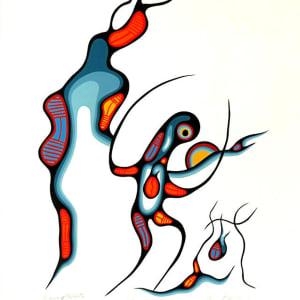
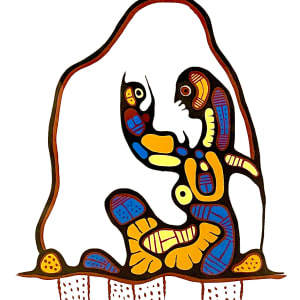
Llyod Kakepetum (1958)
Lloyd Kakepetum (b. 1958) is a self-taught artist from the Keewaywin First Nation in northern Ontario. Influenced by his late uncle, renowned artist Carl Ray, Lloyd's work blends traditional Ojibwa storytelling with intricate detail, primarily using acrylics. His art is deeply rooted in preserving the Anishnabe culture, reflecting the spirit and teachings of his people. Having exhibited in Toronto, Montreal, Vancouver, and other major Canadian cities, Lloyd's pieces are featured in the Thunder Bay Art Gallery and other collections. His distinct style continues to carry forward his uncle's artistic legacy.
Norval Morrisseau (1932-2007)
Norval Morrisseau (Copper Thunderbird) (1932–2007)
Norval Morrisseau, also known as Copper Thunderbird, was a self-taught Indigenous Canadian artist and founder of the Woodlands School of Art. Often called the "Picasso of the North," he revolutionized contemporary Indigenous art with his vivid, spiritual works that depicted Anishinaabe legends, cultural tensions, and personal struggles. His bold use of color and thick black outlines became hallmarks of his style. A Member of the Order of Canada, Morrisseau’s influence extended to generations of Indigenous artists. Despite personal and legal battles, his legacy remains profound, with his works displayed in major galleries worldwide.
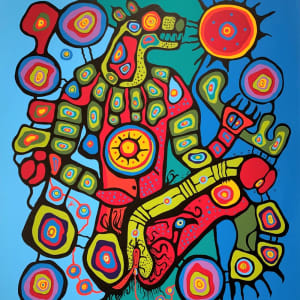
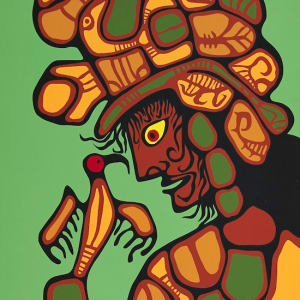
Daphne Odjig (1919-2016)
Daphne Odjig (1919-2016) was a pioneering Indigenous artist and a founding member of the Professional Native Indian Artists Inc. (The Indian Group of Seven). Born on Wiikwemkoong Unceded Territory, Manitoulin Island, she was influenced by her Potawatomi heritage and early artistic training from her grandfather. Odjig's work, spanning six decades, includes narrative legends, personal reflections, and political critiques. Her style evolved from fluid calligraphic lines to bold, expressive history paintings and vibrant ecological works. She was instrumental in bringing Indigenous art into the Canadian mainstream, founding the first Indigenous-owned gallery and advocating for Indigenous artists. Odjig received numerous honors, including the Order of Canada in 1986 and the Governor General's Award in 2007, leaving a lasting legacy in both art and Indigenous cultural preservation.
Abraham Anghik Ruben
Abraham Anghik Ruben is a renowned Inuit artist whose works deeply reflect the cultural heritage and spiritual connection of his people. Born in 1951 in the remote community of Paulatuk, Northwest Territories, Canada, Ruben is a master carver, sculptor, and graphic artist. His artistic practice is grounded in the traditional knowledge and stories of the Inuit, which he incorporates into his sculptures and works on paper.
Ruben's art has been featured in exhibitions worldwide, and he has received numerous accolades for his contributions to the world of Indigenous art. His works are housed in prestigious institutions such as the National Gallery of Canada, the Canadian Museum of History, and the Winnipeg Art Gallery. Through his artistry, Ruben continues to share the stories of his people and culture, ensuring that the rich heritage of the Inuit community is preserved for future generations.
George Arlook (1949-2023)
George Arluk (born May 5, 1949, in Winnipeg, Manitoba) was a prominent Inuit artist known for his abstract sculptures. The fourth of seven children, Arluk was the only one in his family to pursue a full-time art career. He began carving at age nine, self-teaching and drawing early influences from artists like Tiktak, Kavik, and John Pangnark during his time in Rankin Inlet (1956–1975). By the mid-1970s, Arluk developed a unique style, focusing on abstract representations of the human figure, including hunters and mothers with babies. His work often featured groupings of figures with soft, curving forms, reminiscent of Henry Moore’s sculptures. Arluk is widely regarded as one of the leading artists of the Keewatin region.
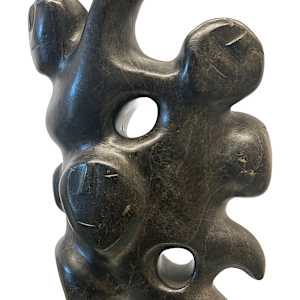
Sydney Kirkness (1950-2010)
Sydney Kirkness (1950–2010) was a dedicated painter from Opaskwayak Cree Nation, Manitoba. He studied at Red Deer College and the Banff School of Fine Arts, where his work remains in the permanent collection. Known for his deep connection to his Indigenous heritage, Kirkness’s paintings reflect a profound sense of place and cultural identity. He lived and worked in Fisher River, Manitoba, where he passed away in 2010.
Joshim Kakegamic (1952-1993) - Anishinaabe (Cree)
Joshim Kakegamic was an Ojibwe artist from Sandy Lake First Nation, Ontario, known for his contributions to Woodland Art. Mentored by Norval Morrisseau and Carl Ray, he began painting in the late 1960s and later conducted workshops across Ontario.
In 1973, Kakegamic co-founded the Triple K Cooperative with his brothers, creating a platform for Indigenous artists to print and promote their work. The cooperative became a major Indigenous economic initiative in Northwestern Ontario. His paintings were exhibited in Canada and internationally, including at Canada House in London.
Kakegamic tragically passed away in 1993 while attempting to save a drowning person. His work is held in major collections, including the McMichael Museum, the Canadian Museum of History, and the Royal Ontario Museum.
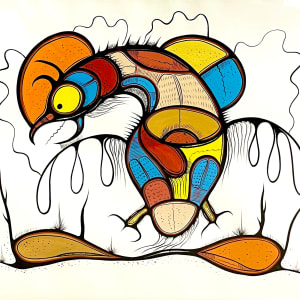
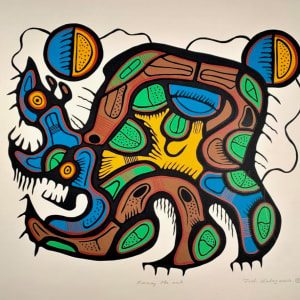
Maxwell Bates (1906-1980)
Maxwell Bates CM RCA LL.D (1906–1980) was a Canadian architect and expressionist painter known for his distinctive fusion of art and architecture. Born in Calgary, Alberta, he began painting at an early age before studying under Lars Jonson Haukaness. In the 1930s, he moved to England, where he exhibited alongside artists like Barbara Hepworth and Victor Pasmore.
During World War II, Bates was captured as a prisoner of war, an experience later reflected in his book A Wilderness of Days (1978). After returning to Canada, he balanced his architectural career—most notably designing St. Mary’s Cathedral in Calgary—with his artistic pursuits.
His paintings, often marked by emotional intensity and bold expressionist forms, have been exhibited internationally. Bates was a member of numerous prestigious art societies and was honored with an Order of Canada in 1980. His legacy endures through his contributions to Canadian modernist art and architecture.
Leo Mol (1915-2009)
Leo Mol, born Leonid Molodozhanyn in Polonne, Ukraine, was a renowned Ukrainian-Canadian artist celebrated for his work in sculpture, painting, and stained glass. Mol studied at the Leningrad Academy of Arts before emigrating to Canada in 1948. He became known for his monumental sculptures, including busts of prominent figures such as Taras Shevchenko and Terry Fox, and public works displayed across Canada, the U.S., and Europe.
Mol’s contributions to the arts include the Leo Mol Sculpture Garden in Winnipeg, housing over 300 of his works. His art earned him numerous honors, including the Order of Canada and honorary degrees from multiple Canadian universities. Mol passed away in 2009, leaving a lasting legacy in public art and sculpture.
Lucy Tasseor Tutsweetok
Lucy Tasseor Tutsweetok (1934–2012) was an Inuk artist renowned for her sculptures, primarily crafted from grey steatite, a stone native to Arviat, Nunavut. After moving to Arviat in 1962 following the closure of the North Rankin Nickel Mine, Tasseor Tutsweetok’s work focused on maternal and family themes, often portrayed through minimalist, semi-abstract forms. She embraced the natural characteristics of the stone, leaving its surface unpolished to retain its original essence. Her work has been featured in significant exhibitions such as Sculpture/Inuit: Masterworks of the Canadian Arctic and In the Shadow of the Sun: Contemporary Indian and Inuit Art in Canada. In 1992, she completed a large sculpture for the Canadian Museum of Civilization. Tasseor Tutsweetok's approach to carving and her calculated drawings upon the stone’s surface resonate with her contemporaries Andy Miki, John Panaruk, and Elizabeth Nutaluk. Her legacy continues to influence Inuit art, and her first solo exhibition was held at the Art Gallery of Ontario in 2011.
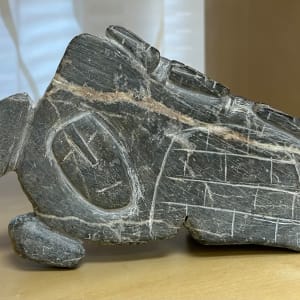
Sampson-Matthews Collection
The Sampson-Matthews print program was the largest public art project in Canadian history. Launched at the start of the Second World War, it lasted twenty-two years and cost tens of millions of dollars in today’s currency. At its height, it employed many of the country’s best commercial painters, designers and artists, working full-time to create masterpieces of serigraphy.
Albert Robinson (1881-1956)
Albert Robinson (1881–1956) was a Canadian painter known for his landscapes and portraits, with a particular focus on capturing the beauty of the Canadian wilderness. Born in Ottawa, Robinson studied at the Art Association of Montreal (now the Montreal Museum of Fine Arts) and was influenced by the Group of Seven, especially in his depiction of the rugged landscapes of Canada. He worked in both oil and watercolors, often drawing inspiration from Quebec’s forests, rivers, and rural settings. Robinson’s style combined elements of realism and impressionism, and he gained recognition for his ability to convey the light and atmosphere of the Canadian landscape. His work continues to be celebrated for its contribution to Canadian art.
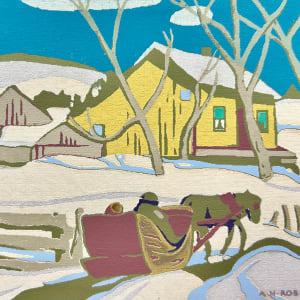
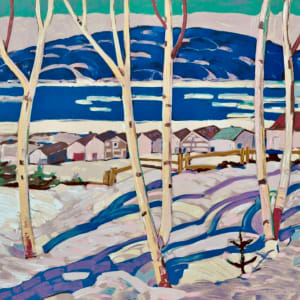
Arthur Beech (1876-1948)
Arthur Beech (1876–1948) was a British-born Canadian artist, educator, and social activist based in Winnipeg. Trained at the Oldham School of Art and the Winnipeg School of Art, Beech was a versatile artist who made significant contributions to the local art scene. He taught manual arts, served as President of the Winnipeg Sketch Club, and co-founded the Manitoba Society of Artists. Beyond his artistic endeavors, Beech was deeply committed to social justice and remained an active member of various political parties throughout his life.
Henry Eric Bergman (1893-1956)
Henry Eric Bergman (1893-1958) was a German-born commercial artist who immigrated to Canada in 1913. A skilled wood engraver, he worked for Brigden's Limited in Winnipeg and contributed to the Eaton’s catalogue. Known for his black and white wood engravings, Bergman also worked in pencil, watercolour, oil paint, and colour woodblock printing. His subjects included Winnipeg, rural Manitoba, Lake of the Woods, and Banff, often inspired by nature, music, and urban landscapes. A founding member of the Winnipeg Art Gallery and past president of the Manitoba Society of Artists, his work is held in several major collections, including the Winnipeg Art Gallery and the National Gallery of Canada. Bergman passed away in Winnipeg in 1958.
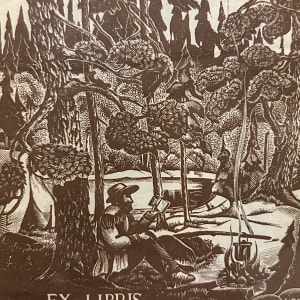
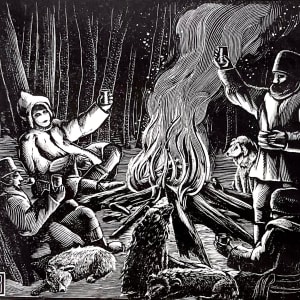
Kenneth Gordon (1929-1998)
Kenneth Gordon was a Manitoba artist known for his expressive landscapes and dedication to Canadian scenery. He spent over two decades teaching art at R.B. Russell Vocational High School before founding Winnipeg’s Medea Gallery and later pursuing painting full-time in Winnipeg Beach.
Influenced by Emily Carr and A.J. Casson, Gordon traveled extensively across Canada, capturing the country’s natural beauty with gestural brushstrokes. His work reflects a deep connection to the land and its history. His paintings remain celebrated for their evocative portrayal of Canada’s landscapes.

